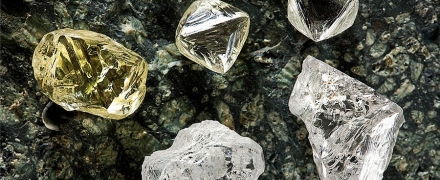open 10 am - 7 pm
laboratory is closed
Diamond Jubilee

On October 23, 1992, almost 30 years ago, a significant event took place - the first diamond in Yakutia was cut at the Suntar plant of the Sakha-Japan Diamond joint venture (Tuymaada-Diamond [Yakutia] and Arda-Company [Japan]). . According to the certificate issued by the President of the Republic of Sakha (Yakutia) M.E. Nikolaev, the weight of the original diamond was 0.546 carats, and the finished diamond was 0.270 carats. And although the stone was not outstanding either in terms of size or quality characteristics (color - G, clarity - SI1), but this stone became a milestone in the development of diamond processing. Until that moment, all mined diamonds went to the Gokhran, and then distributed among producers and buyers, but since 1990, the President of the Republic of Sakha (Yakutia) M.E. Nikolaev set the task of creating a cutting production in the republic. As a result of negotiations between the Presidents of Russia and the Republic of Sakha (Yakutia), since 1991, NPO Yakutalmaz received the right to keep 10% of mined gem diamonds and gold. From the same year, a plan was also developed to create a joint cutting enterprise in the countryside of the Republic of Sakha (Yakutia). On February 19, 1992, NPO Yakutalmaz was transformed into Joint Stock Company Diamonds of Russia - Sakha (ALROSA), and in the same year a diamond trading enterprise was opened in Yakutsk. The launch of the joint venture and the start of the production of finished cut stones was a long-awaited result, which made it possible to concentrate the full cycle of the diamond complex in Yakutia - from mining to cutting finished diamonds. True, it should be said that the first Yakut diamond was cut by a cutter (Tokuda-san) from Japan, as was the sawing of the diamond (Yamada-san).
В геммологической практике бывают весьма увлекательные случаи с диагностикой ювелирных вставок
Но помимо редкости цвета и высокой стоимости таких камней, многие розовые камни выделяются одной замечательной особенностью – они проявляют плеохроизм, то есть в зависимости от положения осмотра камня он может иметь дополнительные оттенки – оранжевый или пурпурный.
Currently, gemstones are produced by two fundamentally different technological methods - the High Pressure - High Temperature method (“HPHT”, High-pressure & High-temperature) and the Chemical Vapor Deposition (“CVD”, Chemical vapor deposition) method. The "HPHT" method is the most tested classical synthesis method, which can be used both carbon deposition on diamond from flux melts and catalytic reactions. In "CVD" synthesis, diamond growth occurs on a seed during carbon deposition mainly from a gaseous medium at relatively low temperatures and pressures.
Jewelry and precious stones are just such a category of goods, when buying which you need to pay attention to many criteria.
Sogdianite is a rather rare mineral and more often it can be found as a collection material (moreover, in systematic collections), and it is extremely rare in jewelry.






